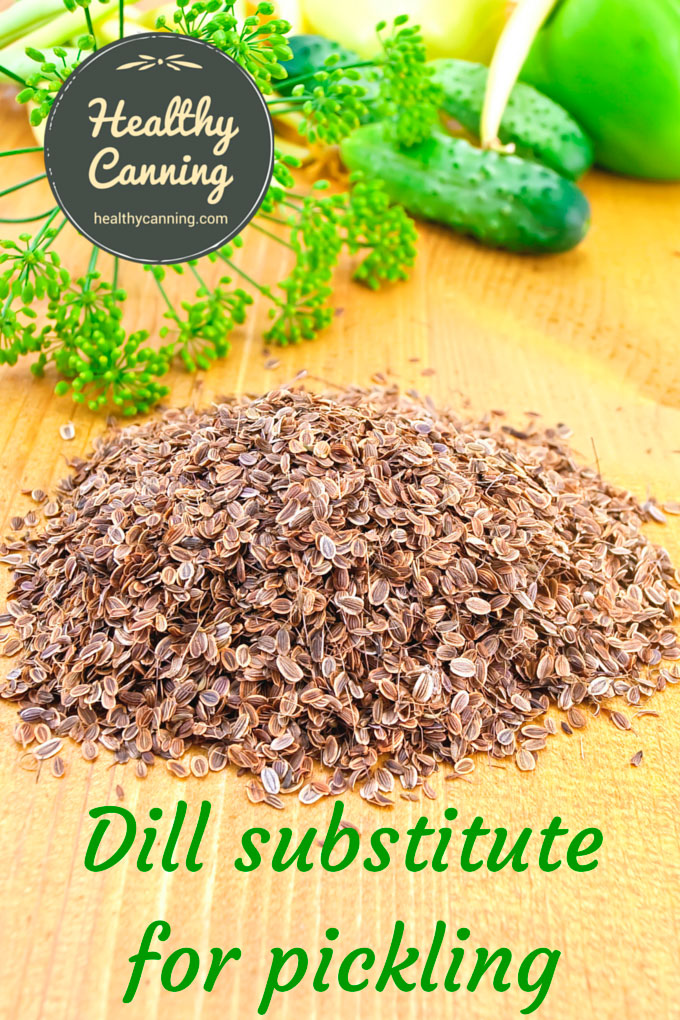In real life, outside of coffee-table beautiful home canning books, some gardeners may find that their cucumbers are ready before their dill weed is.
Other canners will find that their store has a deal on cucumbers but there’s no fresh dill weed within miles to be found.
Or it’s the dead of winter, you are doing winter canning with imported cucumbers (despite the very remote odds of getting a crisp pickle with them), and the balcony where you grow your herbs in the summer has howling winds from Siberia whistling through it off of Lake Michigan.
So, you need to substitute some dried dill for the fresh. Purists may say “perish the thought”, but here’s some tips on how:
(Note: an umbel is a whorl, a round circle spray of the plants buds or flowers.)
Linda Ziedrich says that if a recipe calls for a fresh dill umbel and you don’t have one, use one teaspoon of dried dill seed instead. [1]Ziedrich, Linda. The Joy of Pickling. Boston, Massachusetts: The Harvard Common Press. 2009. Page 14.
For a 3-5″ (8 to 12 cm ) sprig of fresh dill, you can substitute ¼ teaspoon of dried dill weed.
The National Center for Home Food Preservation says, “For each quart, try 3 heads of fresh dill or 1 to 2 tablespoons dill seed (dill weed = 2 tablespoons).” [2] National Center for Home Food Preservation. Frequently Asked Pickle Questions. Accessed March 2015. [Ed: It’s not clear what they mean by the dill weed = addition at the end there: perhaps it means OR 2 tbsp dill weed. ]
If you do try to grow some dill herb, in a small patch of garden or in a window box, don’t plant the seed all at once. In her recipes in The Joy of Pickling, Linda Ziedrich is a big believer in using fresh herbs, even suggesting that it’s worth trying to grow some dill yourself, staggering the planting every few weeks until midsummer so that you have a constant supply as it matures. She says that fresh dill seeds taste very different; that they “taste fresh and mild” before they dry out. [3]Ziedrich, Linda. The Joy of Pickling. Page 14.
If you’ve got a surfeit of fresh dill, you can freeze it. There’s no need to futz with ice cube trays. Just wash, and roll up in plastic bags, held in a log shape with rubber bands. (You may wish to double-bag it, to help prevent its aroma from passing to other foods near it in the freezer.) Plan to replace it within a year, as its flavour will fade. To use in pickling, just thaw first.
Many people feel that dill weed freezes more successfully than it dries. Others feel it becomes too “anisey”.
References


Ann Evens
What can I replace dill seeds for when pickling okra to get the similar flavor?
Terence
Can dill seed be used in lieu of dill heads, in a recipe? If so, how much seed would substitute for a head of dill?
Andrea
Can I use dry dill weed to make pickles?
Healthy Canning
Yes
Dave
Can I use fresh dill weed vs fresh dill heads to can pickles?
Healthy Canning
Yes.
Lisa
Can I use fresh dill sprigs instead of fresh dill heads for refrigerator pickles
Healthy Canning
Yes.
Victoria
I have a recipe that calls for dill sprigs. It does not specify wether they should be dried or not. Can I substitute dill seeds for a sprig and how much?
Healthy Canning
As per above discussion.
Russell
Hello I’m in trouble I’m getting bucket Louds of pickling cucumbers is there a recipe for the best garlic dills for I didn’t see one on this site
Healthy Canning
The Ball Blue Book recipe calls for garlic; you can find it here: https://www.healthycanning.com/dill-pickles/
Donna
Hi, I just read your question for garlic dills. For years I’ve just added fresh garlic cloves to my dill pickles, everyone just loves them.